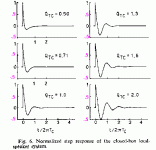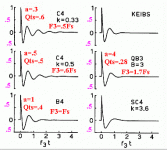Hello.
I am planning to build 4 surround speakers for my home cinema. Each surround speaker will consist of 3 x 5" Vifa P13WG-10-04 woofers and 3 x 1" Vifa TC26TG05-06 tweeters. The heigth of each speaker will be around 1,5m or so. I want to build them as tall pillars, with a small a footprint as possible.
So, the question; if I shrink the volume of a closed box so much that the Q goes toward 0,8 or even 1, how will it affect the sound? Will it be audible? I understand that the f0 of the system will rise and the f3 will of course increase, but apart from that.
Since these speakers will have a lot of cone area and thus displacement, I was planning to let a Linkwitz transform circuit do the job of lowering the Q to 0,707.
Waddaya think?
I am planning to build 4 surround speakers for my home cinema. Each surround speaker will consist of 3 x 5" Vifa P13WG-10-04 woofers and 3 x 1" Vifa TC26TG05-06 tweeters. The heigth of each speaker will be around 1,5m or so. I want to build them as tall pillars, with a small a footprint as possible.
So, the question; if I shrink the volume of a closed box so much that the Q goes toward 0,8 or even 1, how will it affect the sound? Will it be audible? I understand that the f0 of the system will rise and the f3 will of course increase, but apart from that.
Since these speakers will have a lot of cone area and thus displacement, I was planning to let a Linkwitz transform circuit do the job of lowering the Q to 0,707.
Waddaya think?
The first question that comes to mind is how are you going to wire the 3 drivers? Certainly not in parallel as the impedance will drop to low. There is no reasonable series/parallel combination. That leaves in series, resulting in 12 ohms. Is that what you want?
Hello again.
Sorry, forgot to mention that I have to build a 24 channel (!) LM3886 amp...Will feed it from a +/- 13V supply or so.
🙂
Sorry, forgot to mention that I have to build a 24 channel (!) LM3886 amp...Will feed it from a +/- 13V supply or so.
🙂
The transform circuit will work well. Interesting with the 24 3886's, but I wonder if it wouldn't be possible to fix it with fewer amps. I hear that the more speakers you have in a surround system, the better it gets. If you already have the speakers (which might be the reason for the odd (3) number of mids?) you might want to consider splitting the speakers in several boxes and possibly add extra tweeters. Dunno how, really, but it is an idea.
Svante.
You are correct. A while ago I stumbled opun these speaker units. They were half price and I just got paid...🙂
So, that is the reason for the odd arangement. And DD7.1 and DTS 7.1 needs four surround channels...
I was also thinking about building 12 small enclosures and install them around me, but my future girlfriend may have something to say about that.
My question was really if a total Q of, say 0.8 sounds bad, other than having no bass? And would the Linkwitz circuit be able to bring it down to 0,707 with no other drawback than the increased excursion at lower frequencies?
You are correct. A while ago I stumbled opun these speaker units. They were half price and I just got paid...🙂
So, that is the reason for the odd arangement. And DD7.1 and DTS 7.1 needs four surround channels...
I was also thinking about building 12 small enclosures and install them around me, but my future girlfriend may have something to say about that.
My question was really if a total Q of, say 0.8 sounds bad, other than having no bass? And would the Linkwitz circuit be able to bring it down to 0,707 with no other drawback than the increased excursion at lower frequencies?
Your idea is OK, but watch the Linkwitz Transform. There are certain combinations of before and after that you can't do. You may not be able to achieve the equalised F3 that you want and have to go a little lower, resulting in excursion and/or power problems.
The Dudster said:Hello.
So, the question; if I shrink the volume of a closed box so much that the Q goes toward 0,8 or even 1, how will it affect the sound? Will it be audible?
From the early days when the Closed Box was first understood, speaker designers went for a Qtc between 0.7 and 1.0. There were perfectly good, respectable systems on the market with a Qtc = 1.0. They shied away from Qtc's higher than that.
So the short answer to your question of audibility will be: a rise to Qtc = 1.0 might be slightly audible, but not much. I severely doubt you will ever be able to hear the difference between 0.7 and 0.8.
I understand that the f0 of the system will rise and the f3 will of course increase, but apart from that....I was planning to let a Linkwitz transform circuit do the job of lowering the Q to 0,707.
Waddaya think?
I think it is a waste of time to bother lowering the Qtc from 0.8 to 0.7. There just isn't enough difference in sound to make it worthwhile.
Below are the step response graphs for various values of Qtc. These are taken from a Journal Of The Audio Engineering Society article written by Richard Small, of Thiele-Small fame. Notice the similarity in shape between Qtc = 0.7, and Qtc = 1.0. The graph for Qtc = 0.8, while not shown, will be a lot closer to that of Qtc = 0.7 than it will be for Qtc = 1.0. And there isn't much between 0.7 and 1.0 to start with.
Attachments
Now compare those with the step response of various vented boxes. While some vented boxes are tighter than others, no vented box alignment is anywhere near as tight as even a Qtc = 1.0 setup is.
And yet vented box alignements are used in most boxes,adn are considered to give good performance. I am a vented box fan myself, I like the extra bass. But look at the difference in step response between vented box alignments and closed box alignments.
The step response becomes tighter the higher you go above the system resonance. Down in the bass range, where these systems' resonances are, the difference in step response is much, much less audible than it is in the midrange.
So relax, the difference between two closed boxes of Qtc = 0.7 and Qtc = 1.0 is really not that much, let alone the difference between Qtc = 0.7 and Qtc = 0.8.
And yet vented box alignements are used in most boxes,adn are considered to give good performance. I am a vented box fan myself, I like the extra bass. But look at the difference in step response between vented box alignments and closed box alignments.
The step response becomes tighter the higher you go above the system resonance. Down in the bass range, where these systems' resonances are, the difference in step response is much, much less audible than it is in the midrange.
So relax, the difference between two closed boxes of Qtc = 0.7 and Qtc = 1.0 is really not that much, let alone the difference between Qtc = 0.7 and Qtc = 0.8.
Attachments
Thank you for a great reply!
You are confirming what I thought to be true. I knew about those step responses for the closed boxes, but have never seen the same for the ported boxes. I had no idea a ported box had such a bad transient response.
I found that the 5" woofer needs about a 10 liter closed box for a f3 of 100Hz and a Q of 0,8. Below f3 the rolloff is second order, right? I will be using a full Linkwitz Phoenix system in the front, ie with the two 2 x 12" XLS dipole woofers as well as two 4 x 8" Seas subwoofers. There should be enough displacement in those babies to support the surrounds as well.
My mind is spinning like mad now, thanks!
🙂
You are confirming what I thought to be true. I knew about those step responses for the closed boxes, but have never seen the same for the ported boxes. I had no idea a ported box had such a bad transient response.
I found that the 5" woofer needs about a 10 liter closed box for a f3 of 100Hz and a Q of 0,8. Below f3 the rolloff is second order, right? I will be using a full Linkwitz Phoenix system in the front, ie with the two 2 x 12" XLS dipole woofers as well as two 4 x 8" Seas subwoofers. There should be enough displacement in those babies to support the surrounds as well.
My mind is spinning like mad now, thanks!
🙂
- Status
- Not open for further replies.
- Home
- Loudspeakers
- Multi-Way
- System Q and closed boxes.

